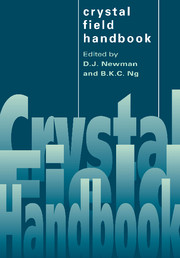Book contents
- Frontmatter
- Contents
- List of contributors
- Preface
- Introduction
- 1 Crystal field splitting mechanisms
- 2 Empirical crystal fields
- 3 Fitting crystal field parameters
- 4 Lanthanide and actinide optical spectra
- 5 Superposition model
- 6 Effects of electron correlation on crystal field splittings
- 7 Ground state splittings in S-state ions
- 8 Invariants and moments
- 9 Semiclassical model
- 10 Transition intensities
- Appendix 1 Point symmetry
- Appendix 2 QBASIC programs
- Appendix 3 Accessible program packages
- Appendix 4 Computer package CST
- Bibliography
- Index
Preface
Published online by Cambridge University Press: 10 December 2009
- Frontmatter
- Contents
- List of contributors
- Preface
- Introduction
- 1 Crystal field splitting mechanisms
- 2 Empirical crystal fields
- 3 Fitting crystal field parameters
- 4 Lanthanide and actinide optical spectra
- 5 Superposition model
- 6 Effects of electron correlation on crystal field splittings
- 7 Ground state splittings in S-state ions
- 8 Invariants and moments
- 9 Semiclassical model
- 10 Transition intensities
- Appendix 1 Point symmetry
- Appendix 2 QBASIC programs
- Appendix 3 Accessible program packages
- Appendix 4 Computer package CST
- Bibliography
- Index
Summary
Our aim in producing this book is to make a wide range of up-to-date techniques for the analysis of crystal field splittings accessible to non-specialists and specialists alike. All of these techniques are based on the phenomenological approach, in which the aims are to
(i) parametrize observed crystal field splittings using models which provide the maximum predictive power,
(ii) test model assumptions directly by means of the quality of parameter fits and the accuracy of their predictions,
(iii) use model parameters as a convenient interface between first principles calculations and experiment.
It is expected that readers will be mainly interested in the first two of these aims. Hence relatively little space is devoted to the description of first principles calculations. While most of the book is concerned with practical applications of the phenomenological approach, some space is given to providing a critical appraisal of relationships between the this approach and other approaches to crystal field theory.
A series of examples, backed with a set of QBASIC programs, is provided to enable readers to rapidly attain proficiency in the basic techniques of phenomenological analysis. Those who wish to embark on more sophisticated analyses are directed to other available program packages. In addition to the procedures covered in the QBASIC programs, the book covers three topics which have barely been touched upon elsewhere.
- Type
- Chapter
- Information
- Crystal Field Handbook , pp. xi - xiiPublisher: Cambridge University PressPrint publication year: 2000

